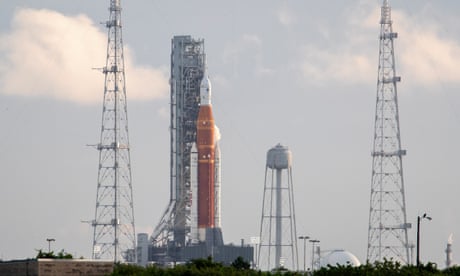Nasa scrubbed the first launch attempt of Artemis 1, the US space agency’s first human-rated moon rocket in 50 years, on Monday because of an “engine bleed” that halted the countdown 40 minutes before lift-off. Artemis 1 rocket: what will the Nasa moon mission be carrying into space? Read more Engineers at Nasa’s launch complex in Cape Canaveral, Florida, discovered the problem with one of the four core-stage engines of the Space Launch System (SLS) rocket during overnight loading of 2. 76m litres (730,000 gallons) of liquid hydrogen and oxygen fuel needed to send the spacecraft off on its 1.
3m-mile, 42-day journey to the far side of the moon and back. They were unable to find a fix in time to meet a two-hour launch window that opened at 8. 33am (1.
33pm BST) on Monday, and they are now troubleshooting the issue to assess readiness for the next available opportunity on Friday 2 September. However, mission managers were not confident of meeting the first back-up date due to the severity of the problem, which arose when engineers increased pressure on fuel lines to “condition” the engines with cryogenic propellant and raise their temperature for launch. The engine “didn’t get the high accuracy temperature that they were looking for”, launch control communicator Derrol Nail said, adding that the rocket would remain fuelled on launchpad 39B at Kennedy Space Center while engineers gathered data.
“The rocket is currently in a stable configuration,” he said. “The team was unable to get past the engine bleed that didn’t show the right temperature and ultimately the launch director has called a scrub for the day,” Nail continued. “Engineers are focused on gathering as much data as they can, so they have not gone to draining the rocket just yet.
” A decision on a next launch attempt was expected later on Monday. The uncrewed Artemis flight is a crucial test mission designed to gauge the capabilities of the SLS rocket and six-person Orion crew capsule ahead of humanity’s planned return to the moon for the first time in half a century. If Artemis 1 ultimately succeeds, astronauts will be onboard an interim test flight along the same route 40,000 miles beyond the moon and back, a trek scheduled for 2024.
The first moon landing since Apollo 17 in December 1972 would follow a year or so later, with Nasa declaring it will carry the first woman to walk on the lunar surface. Upwards of a quarter-million people flocked to Florida’s space coast on Monday to watch a moment in history now postponed to later this week, or even later in September or October, if engineers cannot quickly diagnose and address the cause of the engine bleed. Problems with the rocket, which is made by Boeing, first arose during a “hot fire” test in January last year, when the engines shut down only one minute into a scheduled eight-minute run.
The project at that stage was already almost three years behind schedule and $3bn (£2. 55bn) over budget. Critics say the ultimate cost to the US taxpayer of the Artemis programme, projected to reach $93bn (£79bn) by 2025 , and which has longer-term goals of placing the first humans on Mars in 15 to 20 years’ time, cannot be justified.
A Nasa helicopter flies past the agency’s Space Launch System (SLS) rocket with the Orion spacecraft onboard in Cape Canaveral, Florida. Photograph: Nasa/Getty Images But the Nasa administrator, Bill Nelson, a former space shuttle astronaut, said there was greater purpose in placing new human footprints in lunar soil now from those of the 12 men of the Apollo programme who did so over six missions in a past generation. “We need to be on the moon for much longer periods of time than just landing like we used to, stayed a couple of days and left,” Nelson told NBC’s Meet the Press on Sunday.
“This time we’re going back, we’re going to live there, we’re going to learn there. We’re going to develop new technologies, all of this so we can go to Mars with humans. “All of this is to develop where we may be living on other worlds.
They may be floating worlds, they may be the surface of Mars. But this is just part of our push outward, our quest to explore, to find out what’s out there in this universe. ” Nasa’s shuttle program, which was retired in 2011, limited crewed missions to lower Earth orbit, while private US space companies, including Elon Musk’s SpaceX and Jeff Bezos’s Blue Origin, have flown, or are planning flights, to the International Space Station orbiting 250 miles above Earth.
Artemis is Nasa’s first deep-space exploration project for decades and, unlike the Apollo and shuttle programmes before it, relies heavily on outside contractors and international partners. SLS is designed and manufactured by Boeing. The Orion crew capsule is the brainchild of Lockheed Martin.
And the European Space Agency supplies the service module, the powerhouse of the spacecraft for its lunar journey once the powerful solid rocket boosters and core stage of SLS have placed it beyond Earth’s gravitational pull. The ESM will push Orion farther from Earth than any human-rated space vehicle has ever flown before, providing electricity, water, oxygen and nitrogen and keeping the capsule on course and at the correct temperature before separating and burning up harmlessly in the atmosphere on its return to Earth. .
From: theguardian
URL: https://www.theguardian.com/science/2022/aug/29/artemis-scrubbed-nasa-cancels-moon-launch-engine
